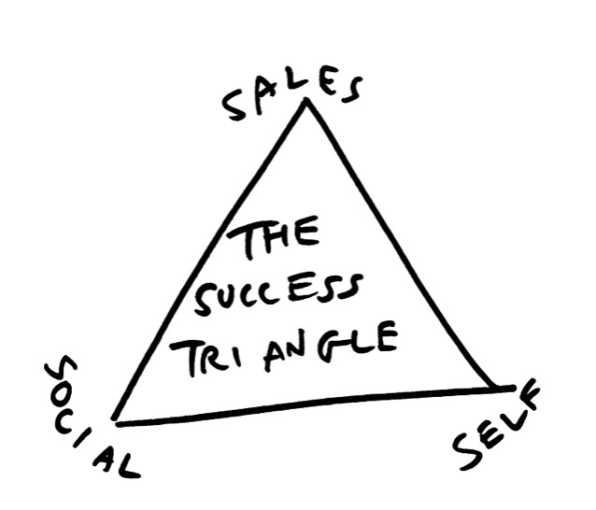Everyone’s resume has a dud or two. Glaring gaps after getting fired. That new boss who reorganized your team–and maybe didn’t like you that much–and gave you a title demotion you’re still embarrassed about. And let’s not forget your short-lived stint as VP of operations at a hypergrowth startup, where your chief responsibility was packing boxes til midnight on Fridays until your partner cried foul.
I feel uncomfortable about parts of my career history, too. I went headfirst into marketing after college before realizing it was an Excel job and I expected a Powerpoint one. I started a restaurant that flopped. I made lateral moves, playing hot potato with my career for about a decade without ever cracking the ranks of leadership.
But what if duds like these aren’t duds? What if they’re simply the points on the zigzagging line that leads to the presently crystallized version of you? Someone with experience, know-how, and the crucial leadership traits of humility and empathy gleaned from working in the battlefields and the trenches–not just commanding the fleets?
Or hey, maybe not. Even so, the ability to take command of your resume–whatever it looks like–and tell a compelling narrative about your career couldn’t be more critical. Selling your experience is a vital skill, whether you’re on a job interview or wooing clients for your solo business. But to do that well, you first need to come to grips with the parts of your job history that you’re least interested in talking about. And that means working your way through these three phases:
Hide
Apologize
Accept
Here’s what that looks like.
PHASE 1: HIDING
For years I was embarrassed that I worked at Walmart. At parties or industry events, I answered the question the same way many of my coworkers did.
Them: So where do you work, anyway?
Me: Retail.
Them: Cool.
Eventually, I started to realize that masking is a form of self-judgment. I wasn’t confident about working at Walmart. I was afraid to mention the company because I was afraid of people’s perceptions: Main-Street-obliterating, fair-wage–damaging, soul-destroying behemoth corrupting society.
By acting awkwardly, I made things awkward for others.
That may not have been true, but whatever they were going to think, I wanted to avoid confronting it. Rather than acknowledge this part of my identity, I hid it. I didn’t mention it in my biography, my blog, any of my books, radio lead-ins, or newspaper interviews.
And I called this humility. But it was really fear. After a few years, I finally figured this out and decided that from then on, I would tell anybody exactly where I worked if they asked. Of course, I did this in a tentative, awkward way.
PHASE 2: APOLOGIZING
It went something like this:
Them: So where do you work, anyway?
Me: (grimacing) Uh . . . Walmart?
Them: Oh, uh, okay, haha . . . yeah, I heard of the place! Haha, uh . . .
By acting awkwardly, I made things awkward for others. By apologizing for myself, I forced others to apologize, too. Eventually, I realized that apologizing was a form of self-judgment in the way that hiding my job history was.
Arguably, it even made things worse. I was communicating a part of myself, then immediately sounding a Family Feud–style buzzer after my own response:
“We surveyed 100 people and the top five answers are on the board. Name a place you have worked.”
“Uh . . . Walmart?”
NNNNNNN!
Apologizing avoids ownership. It creates distance. It suggests a mistake–one that you then need to account for. Apologizing is what you do when your dog craps on the neighbor’s lawn and then you notice your neighbor watching from the window. (Sorry, Keith!)
Do this kind of thing on a job interview, even unwittingly, and a hiring manager will notice immediately. Eventually I clued in to this bad habit myself, and after a couple years of apologizing for my own resume, I finally moved on to the third and final step.
PHASE 3: ACCEPTANCE
Them: So where do you work, anyway?
Me: Walmart.
Them: Cool.
Sounds silly, but it really was that simple. Gone was the tendency to hide the truth from others that reflected my desire to hide it from myself. Gone was the tentativeness and questioning, telling others that I was questioning part of myself–and inviting them to question me, too.
Accepting yourself communicates confidence [and] insulates you from the tide of emotions that wells up whenever other people’s views intersect with your own.
Instead I gained a clear and simple truth, grounded in fact: This is where I’ve worked, and whatever others may think, I still gained some valuable experience from it–experience that helped me make better decisions about my career later on. Ask me about that, and I’d be glad to talk about it.
This way, I consciously remove myself from any possible judgment. And if I am judged negatively, that needs to be wholly owned by the other person–I won’t do their judging for them. The physicist Richard Feynman has said, “You have no responsibility to live up to what other people think you ought to accomplish. I have no responsibility to be like they expect me to be. It’s their mistake, not my failing.”
Accepting yourself communicates confidence, which is a well-known career asset. More than that, it insulates you from the tide of emotions that wells up whenever other people’s views intersect with your own–sometimes muddling your thoughts and bending your beliefs.
What do you do with their views? How do you stop judging yourself? Laugh at it! At least to yourself. A big laugh helps you look deep, examine your self-judgments, and push through the steps to embracing the most (no-longer) cringeworthy parts of your work experience:
H–Hide
A–Apologize
A–Accept
HAA!
Listen, we’re all full of self-judgments: We tell ourselves we’re fat, lazy, don’t exercise enough, aren’t worthy of a raise, aren’t worthy of love, wouldn’t find another job if we were fired or a new significant other if we’re dumped. Those can become dangerously self-fulfilling prophecies if you let them, especially in the job market. Sometimes we forget that we’re all trying our best–all of us–to do better.
It’s a process. And that’s nowhere truer than in our careers; tell yourself you’ve finally “arrived,” and your skills, curiosity, and potential will stagnate in short order.
Find what’s hidden, stop apologizing, and accept yourself. It’s the best thing you can do for your occasionally humiliating resume–and the career you’re rightly proud that it’s led to.
An earlier version of this article originally appeared in Fast Company.





